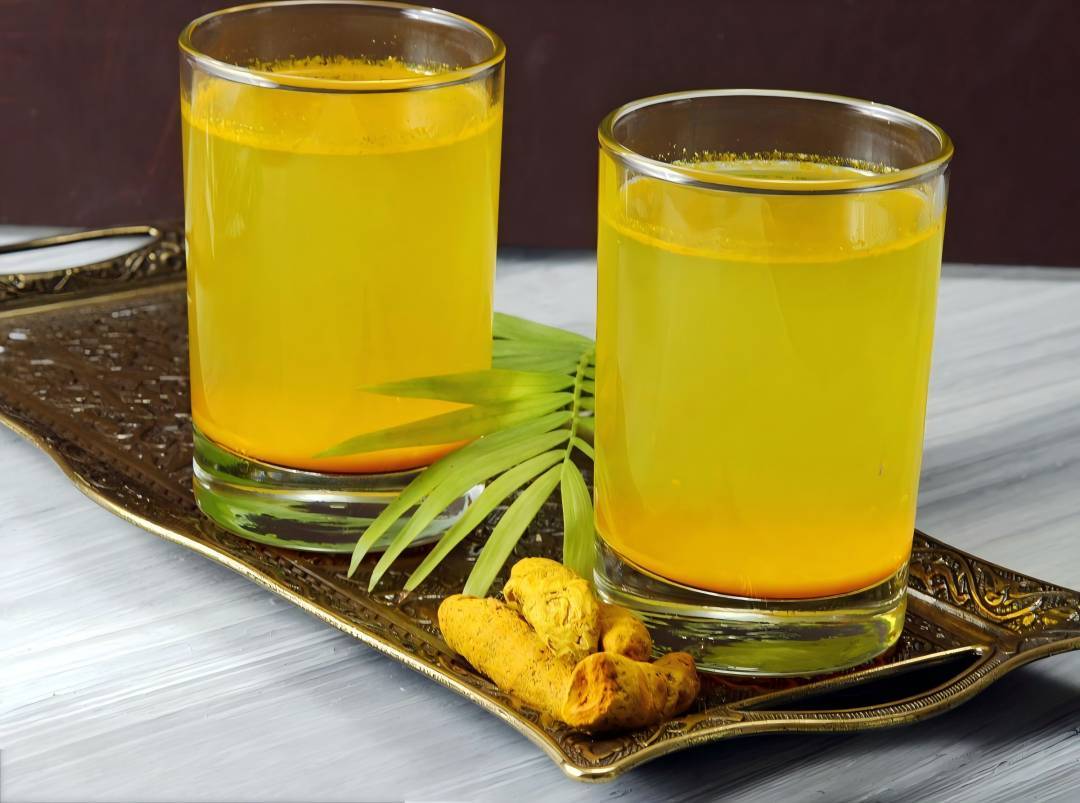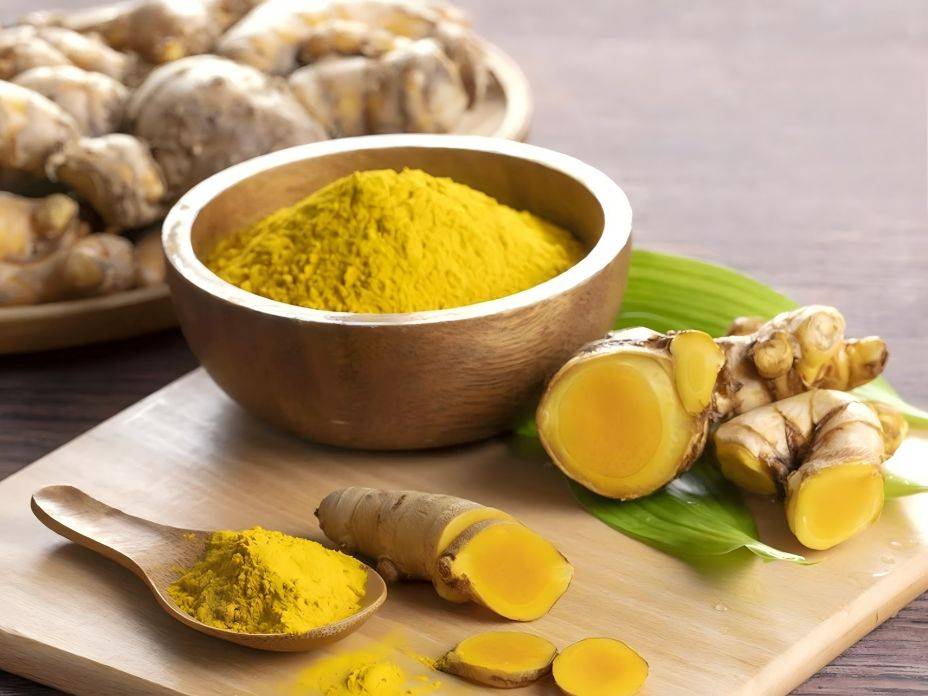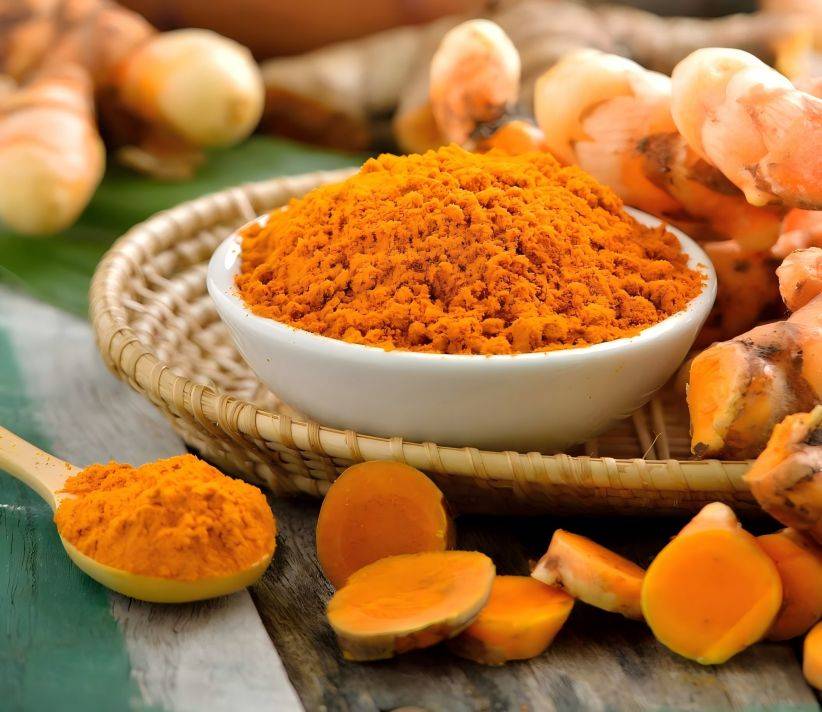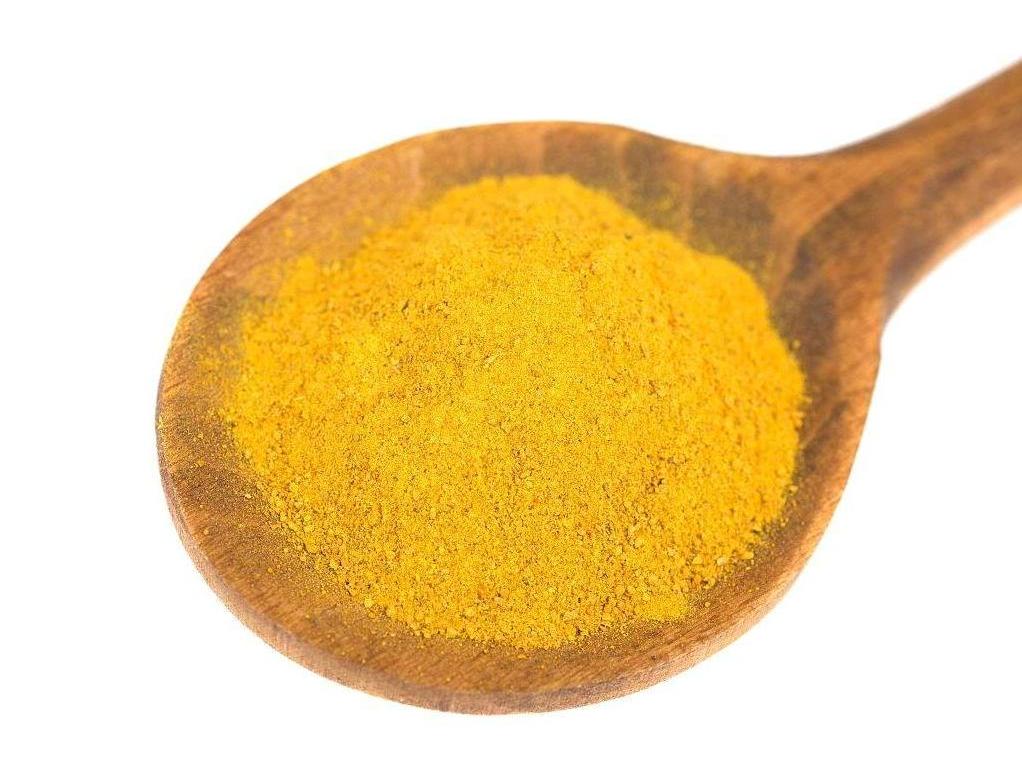Is Turmeric Beneficial for Covid?
Curcumin, a small molecule plant acidic polyphenol obtained from the traditional Chinese medicine turmeric, has a variety of biological activities, such as improving the production performance of livestock and poultry, product quality and immunity, and has great development potential in the actual production of livestock and poultry. Pandey et al. [1] found that curcumin plays a variety of pharmacological roles such as immunomodulation, anti-inflammation, anti-tumor, anti-oxidation and anti-virus by regulating inflammation-related transcription factors and cytokines. It is also a strong antioxidant in vivo and in vitro. Curcumin can also be synthesized into a variety of derivatives, among which curcumin and pyrimidine are the most effective anti-inflammatory drugs [2].
Encapsulating curcumin in microspheres can improve its effectiveness in treating diseases, or using pH changes to encapsulate it in egg white separated protein to improve its dispersibility, antioxidant capacity and thermal stability for efficient use [3].
Yao et al. [4] found that the fluorescent probe assay can be used to analyze curcumin levels, which is very helpful for detecting whether new technologies can improve the bioavailability of curcumin. However, curcumin has certain limitations in use. For example, Liu et al. [5] found that curcumin has obvious time and dose dependence during use, and is unstable in the presence of oxygen, light, and neutral and alkaline environments. It is easily degraded, and curcumin is mainly absorbed by the body through its metabolites. Therefore, its degradation products and metabolites also play an important role. In addition, more and more teams have begun to study whether curcumin has a preventive effect on the COVID-19 virus in some way. This paper reviews the research on curcumin's improvement of metabolic diseases in livestock and poultry through anti-inflammatory, antioxidant, and antiviral functions, and provides new ideas for finding drugs that balance antioxidant and anti-inflammatory effects to prevent livestock and poultry diseases in the context of feed-antibiotic bans.
1 Main physiological functions of curcumin
1.1 Antioxidant effect of curcumin
1.1.1 Curcumin eliminates free radicals in livestock and poultry The molecular structure of curcumin has a 1,2-dihydroxy group and exhibits strong antioxidant activity. Studies have found that curcumin can reduce the accumulation of active free radicals in the body due to metabolism. For example, the methoxy group contained in curcumin can inhibit the formation of reactive oxygen species (ROS) and reduce graphene oxide-induced renal cell death [6-7]. Zhang Jingfei et al. [8] confirmed that bisdemethoxycurcumin (a metabolite of curcumin) can exert good free radical scavenging activity in broiler red blood cells and improve their redox status, just like curcumin.
1.1.2 Curcumin's antioxidant mechanism
Studies have shown that curcumin can control gene expression by activating key transcription factors in signal pathways, thereby up- or down-regulating the expression of genes related to oxidative stress. and inhibit lipid peroxidation, thereby protecting the activity of antioxidant enzymes such as superoxide dismutase (SOD), glutathione peroxidase (GTP), and catalase (CAT). This process requires the participation of the nuclear transcription factor Nrf2 [9]. Li Haoming et al. [10] found that curcumin and its metabolites can eliminate ROS in H2O2-damaged PC12 cells, increase SOD activity, and activate the Nrf2-mediated signaling pathway, resulting in increased expression of NAD(P)H:quinone oxidoreductase 1 (NQO-1) and heme oxygenase-1 (HO-1), thereby reducing oxidative damage to cells and increasing cell survival.
Wang et al. [11] found that the intake of curcumin in combination with baicalin drugs scavenges free radicals by activating the Nrf2/HO-1-mediated signaling pathway, while increasing the expression of downstream antioxidant enzymes NQO1 and HO-1, and reducing T-AOC, SOD, and GSH-Px activity, thereby protecting the rat liver from oxidative damage (Figure 1). Paciello et al. [12] found that curcumin showed antioxidant and protective activity by upregulating the Nrf-2/HO-1 pathway and downregulating p53 phosphorylation. Xie et al. [13] found that in the curcumin treatment group, the Keap1 protein content was significantly increased, the Nrf2 cytoplasmic concentration was decreased, and Nrf2 was also accumulated in the nucleus. which indicates that curcumin can activate the Keap1-Nrf2-ARE signaling pathway in diabetic rats to improve oxidative stress to a certain extent.
The antioxidant effect of curcumin can not only be used in basic research, but is also widely used in animal husbandry practices.
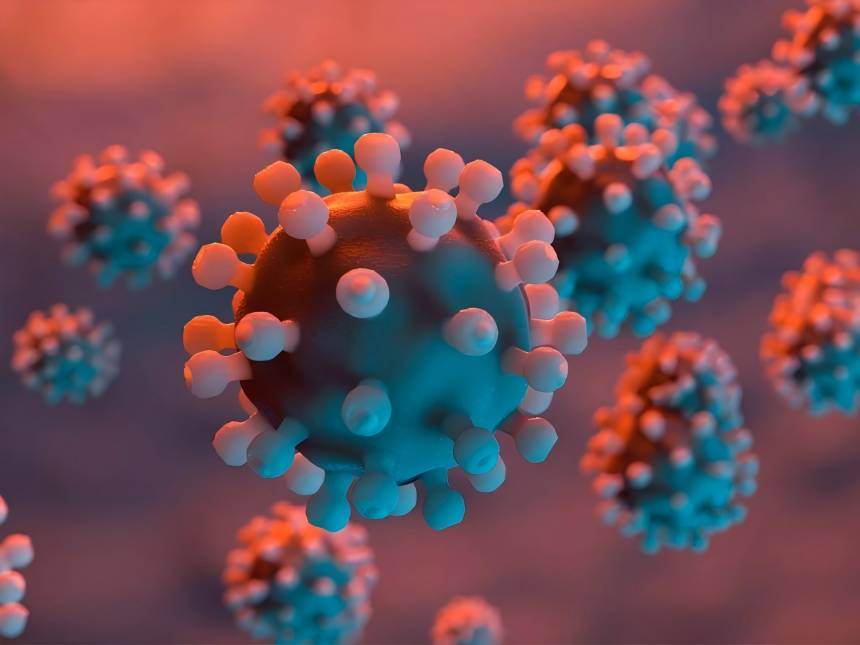
Aamir et al. [14] reported that feeding turkeys with curcumin under heat stress conditions may enhance their antioxidant capacity and improve stress conditions. Curcumin-containing feed can significantly improve the symptoms of mitochondrial swelling in broiler breast muscle caused by chronic heat stress, improve broiler production performance and disease resistance, effectively improve meat quality, and has the potential to replace antibiotics [15].
However, the antioxidant effect of curcumin is not absolute. Galatig et al. [16] showed that curcumin enters the body and is metabolized by the action of peroxidase to produce oxidative phenoxy radicals. Under certain conditions, it can also undergo a co-oxidative reaction with glutathione (GSH) or nicotinamide adenine dinucleotide (NADH). This process requires the absorption of a large amount of oxygen and the formation of ROS, which means that the antioxidant properties of curcumin are not absolute, and under certain conditions it can change from an antioxidant to a pro-oxidant. Therefore, curcumin has a two-sided effect, and different intervention methods can be used for different metabolic diseases in livestock and poultry.
1.2 Anti-inflammatory effect of curcumin
1.2.1 Curcumin regulates the expression of anti-inflammatory genes
Studies have found that curcumin can inhibit the production of pro-inflammatory cytokines such as tumor necrosis factor α (TNF-α), interleukin 1β (IL-1β), interleukin 6 (IL-6) and monocyte chemotactic protein 1 (MCP-1), while also reducing the expression of inflammation-related enzymes such as iNOS [17], to reduce inflammation. Gan et al. [18] found that curcumin and resveratrol can regulate the intestinal flora of weaned piglets, downregulate the TLR4 signaling pathway, reduce intestinal inflammation, and ultimately improve intestinal immune function. Curcumin can also exert an anti-inflammatory effect on mouse glial cells by downregulating microRNA to further regulate cytokine and gene expression [19-20].
1.2.2 Curcumin anti-inflammatory mechanism
Curcumin's anti-inflammatory effect is achieved by regulating many transcription factors, cytokines, protein kinases, etc. Daverey et al. [21] found that curcumin activates the nuclear factor κ-light chain enhancer of B and the nuclear transcription factor 2 (Nrf2) signaling pathway, which exerts its neuroprotective effect and prevents white matter inflammatory damage.
Hernández et al. [22] found that curcumin reduced inflammation in mice by inhibiting the expression of pro-inflammatory cytokines (IL-1β, TNF-α, IL-6, CCL5) in cardiomyocytes, and reducing the activity of cyclooxygenase and nitric oxide synthase. Kim et al. [23] also found that curcumin downregulated the transcription of cyclooxygenase and nitric oxide synthase, thereby exerting an anti-inflammatory effect. Xu Juan et al. [24] found that curcumin inhibited the NF-κB signaling pathway in NLRP3 inflammatory body axis regulation of acute pancreatitis in rats, with a gradual decrease in NF-κB positive expression, an increase in IκBα protein expression, and a decrease in p-p65 and p65 protein expression (Figure 2). This pathway can also regulate cognitive impairment, so curcumin is expected to treat inflammation and cognitive impairment caused by metabolic diseases.
1.3 The antiviral effect of curcumin
Curcumin can inhibit the replication of viruses such as hepatitis B virus, dengue fever virus and Zika virus. For example, it can block HIV-1 replication by inhibiting the activity of the long terminal repeat sequence in the viral genome, which is related to the virulence and replication ability of the virus [25]. At the same time, studies have shown that curcumin can inhibit hepatitis B virus infection by downregulating the acetylation of histones that bind to covalently closed circular DNA [26], or by targeting various signaling pathways such as Wnt/β-catenin, MAPK and NF-κB, it can play a preventive and therapeutic role against hepatitis B virus [27]. Studies have confirmed that curcumin also has a certain inhibitory effect on coronaviruses [28]. Previous studies on the antiviral effect of curcumin on the infectious gastroenteritis virus (TGEV) have found that curcumin can be used as a novel coronavirus inhibitor, but its inhibitory ability still needs further research [29-30].
2 The relationship between curcumin and metabolic diseases in livestock and poultry
2.1 Curcumin improves obesity-related diseases in livestock and poultry
Obesity is one of the main causes of diabetes, cardiovascular disease and certain cancers. It can easily lead to insufficient oxidative phosphorylation and accumulation of ROS, which in turn causes mitochondrial dysfunction. For livestock and poultry, diseases caused by obesity are the main cause of reduced animal productivity. Not only does it cause an imbalance in the nutritional level of products and poor quality meat, eggs and milk, it can also have a detrimental effect on human health. Inflammation caused by obesity can lead to chronic diseases in livestock and poultry, which can cause difficulties in animal husbandry production. Inflammation is related to oxidative function.
Studies have shown [31] that oxidative stress activates the NF-kB signaling pathway and triggers the release of pro-inflammatory cytokines and plasma C-reactive protein (CRP). Turmeric extract can inhibit the NF-kB signaling pathway, and through anti-inflammatory and antioxidant effects, it can improve oxidative stress and inflammation caused by mitochondrial dysfunction, and reduce the occurrence of obesity-related metabolic diseases. Zhao et al. [32] found that the use of curcumin to improve high-fat diet can cause morphological changes in adipose tissue in obese mice, increase the expression of mitochondrial uncoupling protein 1 (UCP1), and promote mitochondrial oxygen consumption in adipocytes. Therefore, curcumin can be used as a food additive to gradually regulate mitochondrial dysfunction in livestock and poultry caused by obesity, improve product quality, and reduce the incidence of chronic diseases.
2.2 Curcumin regulates oxidative stress in type 2 diabetes
Diabetes is a syndrome of disturbed glucose and lipid metabolism, of which type 2 diabetes mellitus (T2DM) is the most typical [33]. The hyperglycemic state of T2DM can induce severe oxidative stress and inflammatory responses, ultimately leading to vascular smooth muscle and endothelial dysfunction and causing death in livestock and poultry. Therefore, appropriate antioxidant drugs are the key to preventing and treating this type of disease.
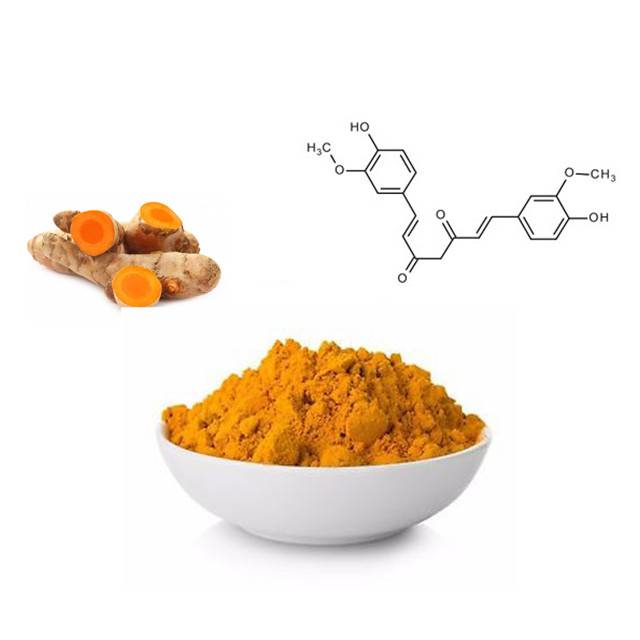
Currently, curcumin is widely used to improve diabetes [34]. Studies have shown that curcumin is a natural product for diabetes and its complications. curcumin can inhibit inflammatory body signal transduction to alleviate this disease [35]; the metabolites of curcumin can enhance insulin sensitivity by enhancing the PI3K-AKT-GSK3B pathway [36]; Chen Jie et al. [37] also found that curcumin activates the phosphoinositide 3-kinase (PI3K)/protein kinase B (Akt) signaling pathway, resulting in a significant increase in the protein expression of p-PI3K/PI3K and pAkt/Akt. At the same time, the insulin sensitivity of T2DM rats was also improved, and the glucose transport status of adipocytes in T2DM rats was improved. Deng Wenrong et al. [38] explored the regulatory effect of curcumin by constructing a diabetes model and found that curcumin can effectively reduce its serum MDA, IL-6, TNF-α, blood glucose, serum insulin, creatinine, 24 h urinary protein, urea nitrogen levels, and kidney coefficient, and increased SOD activity, which improved oxidative stress and inflammation to a certain extent, thereby controlling diabetes. It mainly protects cells by inhibiting ROS production [39].
Diabetes is the main disease in metabolic syndrome, and the treatment of metabolic syndrome is also closely related to oxidative stress and inflammation [6]. Curcumin has a protective effect against oxidative stress damage to the brain, liver and kidneys [40], and can improve metabolic syndrome. Studies have shown that curcumin can significantly reduce the viability of preadipocytes by adding curcumin to the diet to treat metabolic syndrome [41]. Studies have confirmed that curcumin- Piperine combined with short-term supplementation can significantly improve oxidative and inflammatory states [42]. Experiments have further found that dietary intake of curcumin can effectively improve eIF2 signaling and reduce lipid levels in white adipose tissue in mice [43]. Therefore, curcumin not only regulates oxidative stress and inflammatory states in diabetes, but also has a therapeutic effect on metabolic syndrome.
2.3 Curcumin in the treatment of novel coronavirus pneumonia
The novel coronavirus pneumonia that struck in 2020 has attracted the attention of various departments of the country. Many research teams have conducted relevant research on the anti-inflammatory and antiviral effects of curcumin in the treatment of the new crown. Babae et al. [28] described the possible therapeutic effects and molecular mechanisms of curcumin on coronaviruses, and it has a certain effect on effectively controlling the symptoms of patients infected with COVID-19. Curcumin can prevent virus replication in cells. Kumar et al. [44] found that curcumin can target the Nsp9 replication protein through molecular docking, affecting coronavirus replication. Studies have found that curcumin can prevent SARS-CoV-2 from entering cells and replicating [45]. SARS-CoV-2 is a virus that can easily cause pneumonia. Reducing inflammation-related responses is also one of the treatment pathways of curcumin. Saeedi et al. [46] and Valizadeh et al. [47] both showed that curcumin can inhibit the progression of COVID-19 and improve the clinical symptoms of patients with COVID-19 by regulating molecules in inflammatory-related intracellular signaling pathways (NLRP3, Nrf-2, NF-kB, etc.).
Curcumin has good antiviral activity in preventing infection by the coronavirus and the infectious gastroenteritis virus (TGEV), and under certain conditions it can even directly kill the virus [28]. Curcumin inhibits TGEV infection mainly by inhibiting TGEV replication through various pathways in the early stages of infection. Curcumin can directly kill the virus in uninfected cells, and in infected cells, it binds to the virus envelope to inactivate the virus or change the metabolic state of the cell to prevent the virus from invading. Therefore, curcumin will become one of the effective drugs for inhibiting TGEV infection in the future. The effect of curcumin on the prevention and treatment of metabolic diseases in livestock and poultry is shown in Table 1.
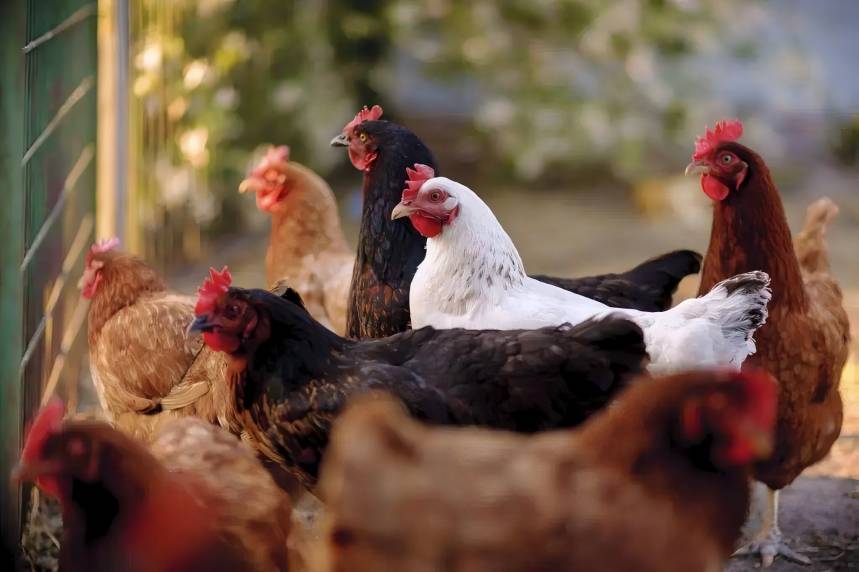
3 Summary and outlook
Curcumin has been widely used in the fields of food and medicine. In recent years, it has received increasing attention in animal husbandry. The growing problem of obesity has brought new challenges to the animal husbandry industry. How to breed livestock and poultry with low fat and high lean meat rate is an important development direction in the future. Curcumin can improve mitochondrial dysfunction by inhibiting ROS formation and regulating genes related to oxidative stress in the Nrf2 pathway and inhibiting the production of pro-inflammatory cytokines in the NF-kB inhibiting the production of pro-inflammatory cytokines in the NF-kB signaling pathway, thereby improving mitochondrial dysfunction. This provides a new solution for the treatment of metabolic diseases in livestock. In 2020, China announced the start of a feed ban on antibiotics in order to ensure ecological safety. This provides a great opportunity for the development of green feed additives such as curcumin, which have obvious effects on improving livestock and poultry production performance, enhancing the quality of livestock products, improving livestock immunity and other aspects of green feed additives with obvious effects provides an excellent development opportunity. Therefore, it can be predicted that it will be one of the research hotspots in the feed industry in animal husbandry.
Some problems have been found in the research on the use of curcumin, mainly including intestinal malabsorption and rapid metabolism when curcumin is directly fed, which leads to low bioavailability and failure to achieve the desired effect. In recent years, solutions to this problem have been proposed one after the other, and the core idea is to use microencapsulation technology to coat curcumin so that it is not completely released during the early release stage, thereby improving its bioavailability. This shows that in addition to the mechanism of action of curcumin itself, which is worth focusing on, the selection of appropriate methods of application is also worth studying based on its physical and chemical properties. Therefore, curcumin has great research value and deserves close attention in future research.
Reference:
[1] Pandey A, Chaturvedi M, Mishra S, et al. Reductive metabolites of curcumin and their therapeutic effects[J]. Heliyon, 2020, 6(11): e05469.
[2] Ahmed M, Qadir MA, Hameed A, et al. Screening of curcumin-derived isoxazole, pyrazoles, and pyrimidines for their anti-inflammatory, antinociceptive, and cyclooxygenase-2 inhibition[J]. Chem Biol Drug Des, 2018, 91(1):338-343.
[3] Wang YX, Zhang L, Wang P, et al. pH-shifting encapsulation of curcumin in egg white protein isolate for improved dispersity, antioxidant capacity and thermal stability[J]. Food ResInt, 2020, 137: 109366.
[4] Yao Z, Liu H, Liu Y, et al. FRET-based fluorometry assay for curcumin detecting using PVP-templated Cu NCs. Talanta[J].2021, 223(Pt2): 121741.
[5] Liu F, Gao S, Yang Y, et al. Antitumor activity of curcumin by modulation of apoptosis and autophagy in human lung cancer A549 cells through inhibiting PI3K/Akt/mTOR pathway[J] . Oncol Rep, 2018, 39(3):1523-1531.
[6] Parada E, Buendia I, Navarro E, et al. Microglial HO-1 induction by curcumin provides antioxidant, antineuroinflammatory, and glioprotective effects[J] . Mol Nutr Food Res, 2015, 59(9): 1690-1700.
[7] Yang H, Du Z, Wang W, et al. Structure-activity relationship of curcumin: role of the methoxy group in anti-inflammatory and anticolitis effects of curcumin[J]. Agric Food Chem, 2017, 65(22): 4509-4515.
[8] Zhang J F, Han H L, Shen M M, et al. Comparative studies on the antioxidant profiles of curcumin and bisdemethoxycurcumin in erythrocytes and broiler chickens[J]. Animals, 2019, 9(11): 953.
[9] Rahban M, Habibi-Rezaei M, Mazaheri M, et al. Anti-viral potential and modulation of nrf2 by curcumin: pharmacological implications[J]. Antioxidants (Basel), 2020, 9(12): 1228.
[10] Li Haoming, Huang Yongjie, Wang Yongli, et al. Protective effect of curcumin and its metabolically modified products on oxidative damage to PC12 cells [J]. Food Science, 2020, 41(15): 208-215.
[11] Wang X X, Chang X H, Zhan H B, et al. Curcumin and Baicalin ameliorate ethanol nduced liver oxidative damage via theNrf2/HO pathway[J]. J Food Biochem, 2020, 44(10).
[12] Paciello Fabiola, FetoniAnna Rita, Mezzogori DanielE, et al. The dual role of curcumin and ferulic acid in counteracting chemoresistance and cisplatin-induced ototoxicity[J]. Sci Rep, 2020, 10: 1063.
[13] Xie Z, Wu B, Shen G, et al. Curcuminalleviate sliver oxidative stress in type 1 diabetic rats[J] .Mol Med Rep, 2018, 17(1): 103-108.
[14] Chen Mingxia, Fang Xinling, Liu Xianxu. Research progress on the physiological functions of curcumin and its application in broiler production [J]. Heilongjiang Animal Husbandry and Veterinary Medicine, 2020(11): 43-46.
[15] Nawab A, Li G H, Liu W C, et al. Effect of dietary curcumin on the antioxidant status of laying hens under high- temperature condition[J]. J Therm Biol, 2019, 86: 102449.
[16] Gacatig, Sabzevario, Wilsonjx, et al. Prooxidant activity and cellular effects of the phenoxyl radicals of dietary oflavonoids and other polyphenolics[J]. Toxicology, 2002, 177(1): 91.
[17] Li Jianshe, He Wenlong, Meng Ke, et al. Effects of curcumin on the NF-κB inflammatory factor signaling pathway in LPS-induced rat astrocytes [J]. Chinese Journal of Gerontology, 2021, 41(5): 1081-1085.
[18] GanZ, Wei W, Li Y, et al. Curcumin andresveratrol regulate intestinal bacteria and alleviate intestinal inflammation in weaned piglets[J] . Molecules, 2019, 24(7): 1220.
[19] Yu Y, Shen Q, LalY, et al. Anti-inflammatory effects of curcumin in microglial cells[J]. Front Pharmacol, 2018, 9: 386.
[20] Ma F, Liu F, Ding L, et al. Anti-inflammatory effects of curcumin are associated with down regulating microRNA-155 in LPS-treated macrophages and mice[J]. Pharm Biol, 2017, 55(1): 1263-1273.
[21] Daverey Amita, Agrawal Sandeep K. Curcumin protects against white matter injury through nf-κb and Nrf2 cross talk[J]. J Neurotrauma, 2020, 37: 1255-1265.
[22] HernAndez M, Wicz S, Caballero E P, et al. Dual chemotherapy with benznidazole at suboptimal dose plus curcumin nanoparticles mitigates Trypanosoma cruzi-elicited chronic cardiomyopathy[J]. Parasitol Int, 2020, 22: 102248.
[23] Kim H, Ban I, Choi Y, et al. Puffing of Turmeric (curcuma longal.) enhances its anti-inflammatory effects by upregulating macrophage oxidative phosphorylation[J]. Antioxidants (Basel), 2020, 9(10): 931.
[24] Xu Juan, Chen Zhuofeng, Wang Zhiwei. Curcumin regulates acute pancreatitis in rats by inhibiting the NF-κB signaling pathway and the NLRP3 inflammatory body axis [J]. Practical Drugs and Clinics, 2020, 23(8): 693-698.
[25] Balasubramanyam K, Varier R A, Altaf Mohammed, et al. Curcumin, a novel p300/CREB-binding protein-specific inhibitor of acetyltransferase,represses the acetylation of histone/nonhistone proteins and his-tone acetyltransferase-dependent chromatin transcription[J]. J Biol Chem, 2004, 279: 51163-71.
[26] Wei Z Q, Zhang YH, Ke C Z, et al. Curcumin inhibits hepatitis B virus infection by down-regulating cccDNA-bound histone acetylation[J]. World J Gastroenterol, 2017, 23: 6252-6260.
[27] Teng C F, Yu C H, Chang HY, et al. Chemopreventive effect of phytosomal curcumin on hepatitis b virus-related hepatocellular carcinoma in a transgenic mouse model[J]. Sci Rep, 2019, 9: 10338.
[28] Babaei F, Nassiri-Asl M, Hosseinzadeh H. Curcumin (a constituent of turmeric): New treatment option against COVID-19[J]. Food SciNutr, 2020, 8: 5215-5227.
[29] Li Y, Wang J, Liu Y, et al. Antiviral and virucidal effects of curcumin on transmissible gastroenteritis virus in vitro[J]. Gen Virol, 2020, 101(10): 1079-1084.
[30] Patel A, Rajendran M, Shah A, et al. Virtual screening of curcumin and its analogs against the spike surface glycoprotein of SARS-CoV-2 and SARS-CoV[J]. J Biomol Struct Dyn, 2021: 1-9.
[31] PanahiY, Hosseini M S, KhaliliN, et al. Antioxidant and anti-inflammatory effects of curcumin oid-piperine combination in subjects with metabolic syndrome:Arandomized controlled trial and an updated meta-analysis[J]. Clin Nutr, 2015, 34(6): 1101-1108.
[32] Zhao D, PanY, Yu N, et al. Curcumin improves adipocytes browning and mitochondrial function in 3T3-L1cells and obese rodent model[J]. R Soc Open Sci, 2021, 8(3): 200974
[33] Jiang Liqing, Li Kaifeng, Zhai Meng'en, et al. Effects of tetrahydrocurcumin on glucose and lipid metabolism and macrovascular disease in type 2 diabetic mice [J]. Chinese Journal of Cardiology, 2020, 32(2): 114-118.
[34] Tang C, Li L, Shi J, et al. Curcumin in age-related diseases[J]. Pharmazie, 2020, 75(11): 534-539.
[35] Lu M, Yin N, Liu W, et al. Curcumin ameliorates diabetic nephropathy by suppressing nlrp3 inflammasome signaling[J]. Biomed ResInt, 2017, 2017: 1516985.
[36] Li P, Ding L Q, Cao S J, et al. Curcumin metabolites contribute to the effect of curcumin on ameliorating insulin sensitivity in high-glucose-induced insulin-resistant HepG2cells[J]. J Ethnopharmacol, 2020, 259: 113015.
[37] Chen J, Liu Y. Effects of curcumin on glucose transport in adipocytes and the PI3K/AKT signaling pathway in type 2 diabetic rats [J]. Chinese Journal of Comparative Medicine, 2019, 29(5): 90-97.
[38] Deng Wenrong, Zhou Zhilin, Li Haiao, et al. Relationship between oxidative stress and renal injury in type 2 diabetic rats and its intervention by curcumin [J]. Chinese Ethnic and Folk Medicine, 2020, 29(18): 21-25.
[39] Wu X, Huang LT, Zhou X L, et al. Curcumin protects cardiomyopathy damage through inhibiting the production of reactive oxygen species in type 2 diabetic mice[J]. Biochem Biophys Res Commun, 2020, 530: 15-21.
[40] Xie Z, Wu B, Shen G, et al. Curcumin alleviates liver oxidative stress in type 1 diabetic rats[J]. Mol Med Rep, 2018, 17(1): 103-108.
[41]Wu LY, Chen C W, Chen LK, et al. Curcumin attenuates adipogenesis by inducing preadipocyte apoptosis and inhibiting adipocyte differentiation[J] . Nutrients, 2019, 11(10): 2307.
[42] Zou H B, Sun X F, The mechanism of curcumin post-treatment relieving lung injuries by regulating miR-21/TLR4/NF-κB signalling pathway[J]. Int Med Res, 2020, 48: 300060520965809.
[43] KoboriM, Takahashi Y, Takeda H, et al. Dietary Intake of curcumin improvese if2 signalingand reduces lipid levelsin the white adipose tissue ofobese mice[J]. Sci Rep, 2018, 8(1): 9081.
[44] Kumar M, Sodhi K K, Singh D K, Addressing the potential role of curcumin in the prevention of COVID-19
by targeting theNsp9 replicase protein through molecular docking[J]. Arch Microbiol, 2021, 203(4): 1691-1696. [45] Kritis P, Karampela I, Kokoris S, et al. The combination of bromelain and curcumin as an immune-boosting nutraceutical in the prevention of severe COVID-19[J]. Metabol Open, 2020, 8: 100066.
[46] Saeedi-Boroujeni A, Mahmoudian-Sani M R, Bahadoram M, et al. COVID-19: a case for inhibiting NLRP3 inflammasome, suppression of inflammation with curcumin[J]. Basic Clin Pharmacol Toxicol, 2021, 128: 37-45.
[47] ValizadehH, Abdolmohammadi-Vahid S, Danshina S, et al. Nano-curcumin therapy, a promising method in modulating inflammatory cytokines in COVID-19 patients[J] .Int Immunopharmacol, 2020, 89: 107088.
[48] Karandish M, Mozaffari-Khosravi H, Mohammadi S M. et al. Evaluation of the effect of curcumin and zinc co-supplementation on glycemic measurements, lipid profiles, and inflammatory and antioxidant biomarkers in
overweight or obese prediabetic patients: a study protocol for a randomized double-blind placebo-controlled phase 2 clinical trial[J]. Trials, 2020, 21: 991.


 English
English French
French Spanish
Spanish Russian
Russian Korean
Korean Japanese
Japanese